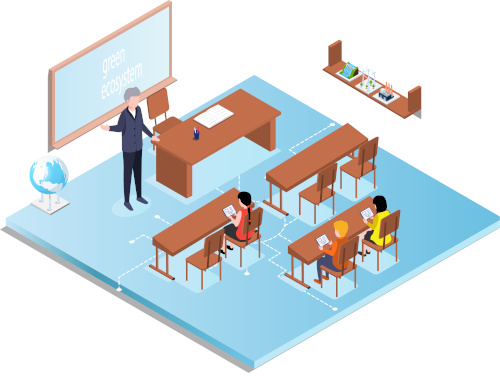One of the definitions from the Merriam-Webster Dictionary defines ecosystem as “something (such as a network of businesses) considered to resemble an ecological ecosystem especially because of its complex interdependent parts.”
When you take a look at a classroom, there are several interdependent parts working together to create a successfully functioning classroom. The students, teachers, technology, curriculum, physical space, and furniture all play a role in creating a successful learning environment–and as we saw with the pandemic, a disruption to this ecosystem can have dire effects.
According to a report by Rand Corporation, teachers’ stress levels are at an all-time high and threaten the teacher pipeline. At the same time, according to a McKinsey Report, the pandemic has caused students to fall months behind in learning math and reading and has caused older students to disengage from their education.
As schools and districts look at solving these issues while also addressing the underlying systemic inequities the pandemic brought to light, in part because of access to technology, education thought leaders and administrators are sharing their thoughts about how classrooms need to evolve. The good news is, there is money available like never before to try new things to put student and teacher needs at the front of innovating.
Here are some of our takeaways:
Make Classrooms Student Centric: As everyone knows, the number of student devices has skyrocketed since the start of remote learning due to the federal funding provided during the pandemic. Although some schools were already 1:1 or had BYOD programs in place, many schools are experiencing this type of learning environment for the first time and without a lot of time to plan.
Educators need help determining how best to incorporate these devices on a daily basis while keeping instruction student centric and personalized. Instead of simple lectures with students as passive recipients, we need to move to students being actively involved in the content and learning skills to prepare them for life, with devices supporting that learning. Schools need to invest in instructional technology coaches and other resources to help teachers personalize learning while making it fun and rewarding for students.
Make Classrooms Flexible: As we have seen with the ongoing pandemic, the need for flexibility is important. As cases surge, schools may need to switch between in-person and remote learning and as we saw last year, simply lecturing via video conferencing is not a successful model. Even when students are in person, active learning requires flexible environments with mobile furniture and modular set-ups that can be moved around as needed. Classrooms need to be comfortable places to learn collaboratively, while allowing for multi-modal learning in whole class, small group and individual settings while providing opportunities for sharing and learning from peers.
Make Learning Immersive: After a challenging and lonely year, it seems like most students want to be in the classroom learning. What they don’t want is to be passive consumers of information. So schools and curriculum providers alike are now trying even harder to make learning immersive. There are more options for gamified and virtual learning being developed to help get students immersed in the content they are learning and to provide hands-on learning so students are learning by doing. One benefit of immersive learning is the reduction of boredom and keeping students busy throughout the day, which leads to less time for behavioral and attendance issues.
Make Learning Equitable: One of the biggest things we learned from the pandemic is that there is a real disparity in access to technology. Students who did not have access to remote teachers, devices, internet, etc. were at a real disadvantage. Schools around the country looked for solutions, including providing hotspots, outfitting busses with devices and internet then driving them to apartment buildings, and installing internet within dwellings where possible. More companies need to partner with schools to solve this problem long-term so that students can have constant access to information and can be learning day and night.
Constantly evolving
The parts of a classroom ecosystem will always play a critical role in education. However, as classrooms continue to evolve, there will be new considerations that arise. Educators continue to find ways for all of these parts, such as technology, classroom design, and instructional materials, to come together to create a stronger and more supported environment for student learning.
- High school students say AI will change the workforce - April 18, 2024
- Motivating students using the Self-Determination Theory - April 17, 2024
- Michigan Virtual’s statewide workgroup releasing AI guidance for K-12 educators - April 17, 2024


